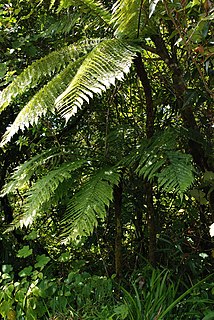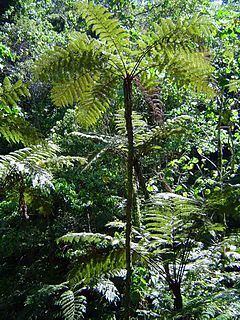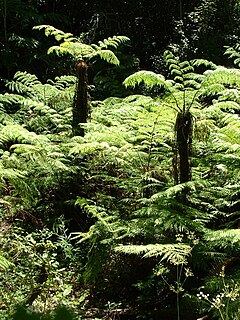
Cyathea medullaris, popularly known as the black tree fern, is a large tree fern up to 20 m tall. It is distributed across the south-west Pacific from Fiji to Pitcairn and New Zealand. It is called mamaku, katātā, kōrau, or pītau in the Māori language.

Cyathea australis, also known as the Rough Tree Fern, is a species of tree fern native to southeastern Queensland, New South Wales and southern Victoria in Australia, as well as Tasmania and Norfolk Island.
Cyathea baileyana, also known as the wig tree fern, is a species of tree fern native to northeastern Queensland in Australia, where it grows in wet gullies and forest at an altitude of 850–1200 m. It is a rare species that is seldom found in the wild. The erect trunk is 4–5 m tall, approximately 10 cm in diameter and may be covered in stipe bases in the upper regions. C. baileyana is notable for being able to develop offshoots from the base of the trunk. Fronds are bi- or tripinnate and may be exceptionally long, up to 7 m, though they are usually around 2–3 m. The rachis and stipe are dark to darkish red, scaly and may be warty, but lack spines. Scales on the rachis and stipe are purplish brown to black and have a long hair-like apex. Characteristically of this species, the last pair of pinnae are separated from the others along the rachis and may form a clump around the trunk apex. Sori are circular and occur in one to three rows along the pinnule midvein. They lack indusia.
Cyathea caudata is a species of tree fern native to the islands of Luzon and Mindanao in the Philippines, where it grows in montane forest. The trunk is erect and up to 4 m tall or more. Fronds are bi- or tripinnate and 1–2 m long. The stipe is warty and covered with dark, narrow, glossy scales. Sori are borne near the midvein of fertile pinnules and are protected by firm, brown indusia.
Cyathea edanoi is a species of tree fern endemic to Luzon in the Philippines, where it grows in montane forest at an altitude of about 1300 m. The trunk is erect and 1–2 m tall. Fronds are bi- or tripinnate and approximately 1 m long. The stipe is covered in dark, glossy scales that have narrow, fragile edges. Sori occur near the midvein of fertile pinnules and are covered, sometimes half-covered, by large, firm, brown indusia.
Cyathea foersteri is a species of tree fern native to eastern New Guinea, where it grows in scrub in forest margins and mossy forest at an altitude of 1600–2800 m. The trunk is erect and up to 10 m tall. Fronds may be bi- or tripinnate and 2-2.5 m long. Usually around nine or ten live fronds are present in the crown at once. The stipe is covered in pale scales. Sori occur near the fertile pinnule midvein and are protected by firm, thin indusia.
Cyathea gleichenioides is a species of tree fern endemic to New Guinea, where it grows in open peaty grassland and on forest margins, often in groups, at an altitude of 2800–3700 m. The trunk of this plant is erect, up to 3 m tall and about 24 cm in diameter. The narrow fronds are tripinnate and about 1 m in length. Around 60 fronds form a rounded crown.The stipe is warty and bears scattered scales towards the base. These scales may be either glossy brown with a paler dull margin, or small, pale and fringed. Sori occur one or two per fertile pinnule and are protected by firm, brown indusia.
Cyathea heterochlamydea is a little-known species of tree fern native to the islands of Luzon, Panay, Negros and Mindanao in the Philippines, where it grows in montane forest. The trunk of this plant is erect and usually up to 4 m tall or more. Fronds may be bi- or tripinnate and 1–2 m in length. The stipe is warty and/or bears short spines and scales. These scales are dark, glossy and have a narrow pale margin. Sori are borne near the fertile pinnule midvein and are protected by firm, brown indusia.
Cyathea khasyana is a species of tree fern. Its natural distribution extends from India to Myanmar, although it is absent from Sri Lanka. C. khasyana grows in forest at an altitude of 1400–1700 m. The trunk of this plant is erect and 5–7 m tall. Fronds may be bi- or tripinnate and 2–3 m in length. C. khasyana has a long, dark stipe that is covered in numerous scales. These scales are dark and have broad, pale, fringed edges. Sori are borne near the midvein of fertile pinnules and lack indusia.
Cyathea propinqua is a species of tree fern native to Fiji and possibly Samoa, where it grows in wet forest. The trunk of this plant is erect and slender, growing to 10 m in height. Fronds may be bi- or tripinnate and 2–3 m long. Dull brown scales cover the dull, dark stipe of this species. The scales are minute along most of its length, becoming thick and fleshy towards the base. Sori are borne halfway between the pinnule midvein and the edge of the lobe. Indusia are present.
Cyathea metteniana is a species of tree fern native to the Ryukyu Islands, Japan, and Taiwan, where it grows in wet forest, forest margins, and on hillsides. The trunk of this plant is erect, up to 1 m tall, and 6–10 cm in diameter. C. metteniana has tripinnate fronds that are 1-2.5 m long. The stipe is brown to purple-black in colouration. It is covered in long, broad-based scales that are usually bicoloured. Sori are round, lack indusia, and occur in two rows, one on either side of the pinnule midvein.
Cyathea imbricata is a species of tree fern endemic to Western New Guinea, where it grows in open forest at an altitude of 3240 m. The trunk of this plant is erect and approximately 2 m tall. Fronds may be bi- or tripinnate and are usually less than 1 m in length. The stipe is dark, spiny, and covered with caducous scales. These scales are glossy brown in colouration and have a paler margin and fragile edges. Sori are borne in groups of one to four per pinnule lobe. They are protected by firm indusia.
Cyathea junghuhniana is a species of tree fern native to southern and central Sumatra and western Java, where it grows in forest at an altitude of 1000–2000 m. The trunk of this species is erect and may be 2 m tall or more. Fronds are tripinnate and up to about 3 m long. The stipes of this species are persistent and form a skirt around the trunk. They are brown, spiny, and covered with glossy, dark brown scales. Sori are borne near the midvein of fertile pinnules and are protected by thin indusia.
Cyathea kermadecensis is a species of tree fern endemic to Raoul Island in the Kermadec Islands, where it is locally common in damp, and sometimes drier, forest and scrub. The trunk of this plant is erect, slender, and up to 20 m tall. It is often covered with scars of old stipe-bases. Fronds are tripinnate and up to 4 m in length. The rachis and stipe are both brown in colouration and bear basal scales that are brown, glossy, and often twisted. Sori are borne on either side of the pinnule midvein. They are covered by hood-like indusia.
Cyathea latebrosa is a common and widespread species of tree fern native to Indochina. Its natural range covers Cambodia and Thailand, and stretches from the Malay Peninsula to Indonesia, where it is present on the islands of Borneo and Sumatra. Plants reported from India and Sri Lanka have thinner indusia and may represent a separate, as-yet undescribed, species. C. latebrosa grows in a wide range of habitats, including forest, secondary forest, and plantations, from sea level up to an elevation of about 1500 m.

Cyathea glauca is a species of tree fern endemic to Réunion. Little is known about this species. C. glauca is not to be confused with Cyathea glauca used as a synonym of Cyathea mexicana.

Cyathea borbonica is a tree fern endemic to Mauritius, Réunion and the islands of the south-western Indian Ocean. There are several natural forms and varieties.

The spiny tree fern or sheshino is a tree fern and one of 326 species of Cyathea. It is readily identified by the fierce spines on its trunk, and is widespread in the tropical regions of Africa.






















